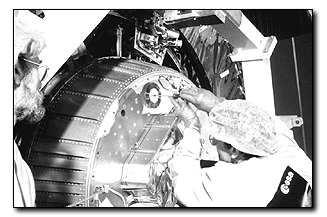![]()
![[ NEWS ]](/images/fall97/newsf97.gif)
![]()
By Greg Clark
Arizona Daily Wildcat October 13, 1997
UA scientists await results of $3.2 billion spacecraft
![[Picture]](01_1_i.gif)
Photo courtesy the European Space Agency This artist's impression shows the Huygens Probe suspended from the stabilizer parachute passing through the atmosphere of Saturn's largest moon, Titan. Huygens and its companion spacecraft, Cassini, were scheduled for launch from Cape Canaveral, Fla., this morning. |
The Cassini/Huygens mission to Saturn, in which several University of Arizona
scientists play key roles, is scheduled for launch today from Cape Canaveral,
Fla.
The $3.2 billion multinational cooperative effort between NASA and the European Space Agency to study the Saturnian system is the last of a generation of multibillion-dollar space missions. Those missions include the two Voyager missions to explore the outer solar system and the Galileo spacecraft orbiting Jupiter.
The craft was scheduled to lift off at 1:55 a.m. Tucson time today.
The Cassini craft will orbit Saturn for four years, using more than a dozen instruments to collect data on the planet's surface, atmosphere, magnetic field, rings and moons.
The orbiter is carrying a detachable craft, the Huygens Probe, that will drop through the atmosphere of Saturn's largest moon, Titan, to analyze Titan's thick atmosphere and its surface.
UA Lunar and Planetary Laboratory scientists Carolyn Porco, Martin Tomasko, Robert H. Brown and Jonathan Lunine are in Florida, eagerly awaiting what they hope will be a flawless launch.
"During the mission, we will be taking hundreds of thousands of images of Saturn and its satellites," said Porco, who is head of the imaging team for the Cassini orbiter.
The images of Titan may be the most interesting because scientists have never been able to penetrate the haze of the gigantic satellite's atmosphere.
"There have been some images taken from the Hubble Space Telescope, and they just tantalize you because you can't see anything," Tomasko said.
Tomasko is head of the imaging team for a camera mounted on the Huygens probe.
"In the last images we get from Huygens before it hits Titan's surface, we'll be able to see areas the size of a typical back yard in Tucson," he said.
Scientists are especially interested in Titan because its atmosphere, composed of nitrogen, methane and hydrogen, may be similar to Earth's atmosphere before life began, Porco said.
"We believe that chemical processes there might have been similar to the processes on early Earth."
Those chemical processes include the production of hydrocarbons as solar radiation reacts with the atmosphere, and may lead to the synthesis of complex molecules.
There may be pools, streams and lakes of methane and ethane on Titan's surface, Tomasko said. There could be methane thunderstorms and lightning too, which may be discovered when Huygens arrives, he said.
The atmosphere of Titan's parent planet also poses questions for scientists.
One question scientists are seeking to answer about Saturn's atmosphere concerns the 1,200 mile-per-hour jet stream around the planet's equator.
"We would like to know why there is such an energetic jet girdling the globe and to know what powers it, with the ultimate goal of gaining some idea of what powers the jet stream on Earth," Porco said.
Porco added she is also interested in Saturn's signature rings.
The rings are composed of innumerable particles of ice, from the size of dust to pieces as big as houses orbiting the planet, she said.
Planetary scientists believe the rings were formed sometime within the past 100,000 years by a catastrophic collision between a meteoroid and a former moon, or by a cometary body passing close to the planet and being torn apart.
"A large body, perhaps 200 to 300 kilometers in diameter, without a lot of structural integrity could have been ripped apart quite easily by Saturn's gravity," Porco said.

Photo courtesy the European Space Agency Technicians install on the Huygens Descent Module the CD-ROM containing more than 100,000 signatures and messages or electronic postcards from Earth to be parachuted to the surface of Titan. The camera that will take pictures of Titan as it descends through the Saturnian moon's atmosphere was designed and is being tested at the UA. |
By measuring the orbits of the particles and analyzing the changes that have occurred since Voyager passed Saturn 20 years ago, scientists should be able to determine the lifetime of the rings, Porco said.
Saturn has 18 moons and each of them has its own unique story to tell about its evolution, Porco said.
"Looking at surfaces of the satellites, we have a record of the history of the solar system since the satellite's formation," she said.
To conserve fuel, Cassini will use the force of gravity as a propellant. The craft will gain speed passing by Venus twice and making passes by Earth and Jupiter. Those planet's gravity will catapult Cassini on its seven-year voyage.
During Cassini's journey, scientists will be testing the instruments and perfecting their interpretation of the data that will be sent back.
"You have to be sort of an optimist to play these games," Tomasko said.
For example, Tomasko said the Huygens camera will function for only a few hours and only if things go right.
"We've been working on this instrument for 10 years, and have another seven to go. At the end of all that, if everything goes well, we will get 2 1/2 hours of data in November, 2004," he said.
The mission has been controversial because Cassini carries 72 pounds of radioactive plutonium to produce electricity to power the instruments.
Opponents of the mission have argued that plutonium could be spewed into Earth's atmosphere if the launch vehicle explodes or if the spacecraft re-enters the atmosphere during its Earth flyby in 1999.
But Porco says Cassini has been designed to be as safe as reasonably possible.
Tomasko agrees.
"The protesters have taken an emotional rather than a rational evaluation of the risk. If you worry about the things that will potentially decrease your life span, you need to worry about driving, sunbathing, drinking, smoking and all the other things we find perfectly appropriate. The launch of the Cassini mission is simply not one of them," he said.



